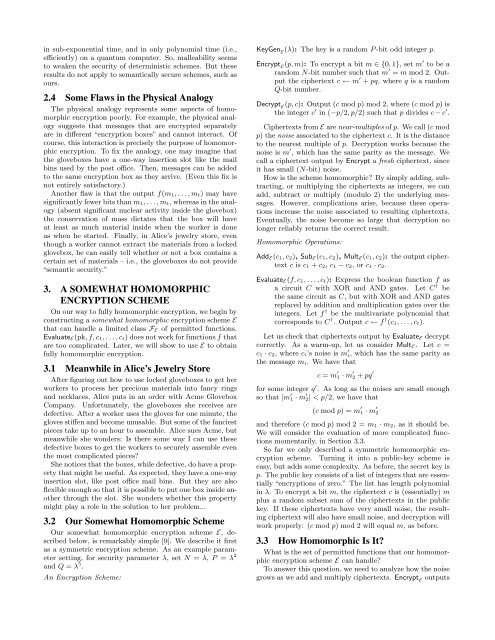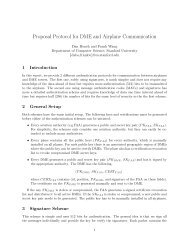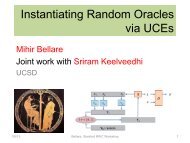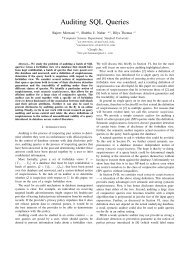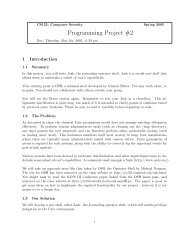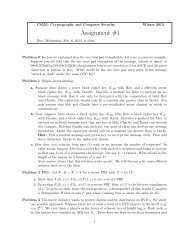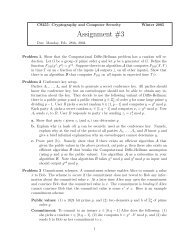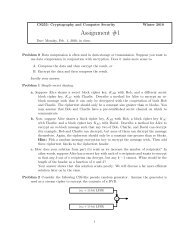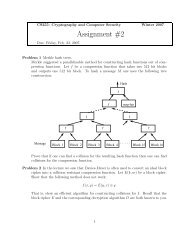Computing Arbitrary Functions of Encrypted Data - Stanford Crypto ...
Computing Arbitrary Functions of Encrypted Data - Stanford Crypto ...
Computing Arbitrary Functions of Encrypted Data - Stanford Crypto ...
Create successful ePaper yourself
Turn your PDF publications into a flip-book with our unique Google optimized e-Paper software.
in sub-exponential time, and in only polynomial time (i.e.,<br />
efficiently) on a quantum computer. So, malleability seems<br />
to weaken the security <strong>of</strong> deterministic schemes. But these<br />
results do not apply to semantically secure schemes, such as<br />
ours.<br />
2.4 Some Flaws in the Physical Analogy<br />
The physical analogy represents some aspects <strong>of</strong> homomorphic<br />
encryption poorly. For example, the physical analogy<br />
suggests that messages that are encrypted separately<br />
are in different “encryption boxes” and cannot interact. Of<br />
course, this interaction is precisely the purpose <strong>of</strong> homomorphic<br />
encryption. To fix the analogy, one may imagine that<br />
the gloveboxes have a one-way insertion slot like the mail<br />
bins used by the post <strong>of</strong>fice. Then, messages can be added<br />
to the same encryption box as they arrive. (Even this fix is<br />
not entirely satisfactory.)<br />
Another flaw is that the output f(m1, . . . , mt) may have<br />
significantly fewer bits than m1, . . . , mt, whereas in the analogy<br />
(absent significant nuclear activity inside the glovebox)<br />
the conservation <strong>of</strong> mass dictates that the box will have<br />
at least as much material inside when the worker is done<br />
as when he started. Finally, in Alice’s jewelry store, even<br />
though a worker cannot extract the materials from a locked<br />
glovebox, he can easily tell whether or not a box contains a<br />
certain set <strong>of</strong> materials – i.e., the gloveboxes do not provide<br />
“semantic security.”<br />
3. A SOMEWHAT HOMOMORPHIC<br />
ENCRYPTION SCHEME<br />
On our way to fully homomorphic encryption, we begin by<br />
constructing a somewhat homomorphic encryption scheme E<br />
that can handle a limited class FE <strong>of</strong> permitted functions.<br />
EvaluateE(pk, f, c1, . . . , ct) does not work for functions f that<br />
are too complicated. Later, we will show to use E to obtain<br />
fully homomorphic encryption.<br />
3.1 Meanwhile in Alice’s Jewelry Store<br />
After figuring out how to use locked gloveboxes to get her<br />
workers to process her precious materials into fancy rings<br />
and necklaces, Alice puts in an order with Acme Glovebox<br />
Company. Unfortunately, the gloveboxes she receives are<br />
defective. After a worker uses the gloves for one minute, the<br />
gloves stiffen and become unusable. But some <strong>of</strong> the fanciest<br />
pieces take up to an hour to assemble. Alice sues Acme, but<br />
meanwhile she wonders: Is there some way I can use these<br />
defective boxes to get the workers to securely assemble even<br />
the most complicated pieces?<br />
She notices that the boxes, while defective, do have a property<br />
that might be useful. As expected, they have a one-way<br />
insertion slot, like post <strong>of</strong>fice mail bins. But they are also<br />
flexible enough so that it is possible to put one box inside another<br />
through the slot. She wonders whether this property<br />
might play a role in the solution to her problem...<br />
3.2 Our Somewhat Homomorphic Scheme<br />
Our somewhat homomorphic encryption scheme E, described<br />
below, is remarkably simple [9]. We describe it first<br />
as a symmetric encryption scheme. As an example parameter<br />
setting, for security parameter λ, set N = λ, P = λ 2<br />
and Q = λ 5 .<br />
An Encryption Scheme:<br />
KeyGen E (λ): The key is a random P -bit odd integer p.<br />
Encrypt E(p, m): To encrypt a bit m ∈ {0, 1}, set m ′ to be a<br />
random N-bit number such that m ′ = m mod 2. Output<br />
the ciphertext c ← m ′ + pq, where q is a random<br />
Q-bit number.<br />
Decrypt E(p, c): Output (c mod p) mod 2, where (c mod p) is<br />
the integer c ′ in (−p/2, p/2) such that p divides c − c ′ .<br />
Ciphertexts from E are near-multiples <strong>of</strong> p. We call (c mod<br />
p) the noise associated to the ciphertext c. It is the distance<br />
to the nearest multiple <strong>of</strong> p. Decryption works because the<br />
noise is m ′ , which has the same parity as the message. We<br />
call a ciphertext output by Encrypt a fresh ciphertext, since<br />
it has small (N-bit) noise.<br />
How is the scheme homomorphic? By simply adding, subtracting,<br />
or multiplying the ciphertexts as integers, we can<br />
add, subtract or multiply (modulo 2) the underlying messages.<br />
However, complications arise, because these operations<br />
increase the noise associated to resulting ciphertexts.<br />
Eventually, the noise become so large that decryption no<br />
longer reliably returns the correct result.<br />
Homomorphic Operations:<br />
AddE(c1, c2), SubE(c1, c2), MultE(c1, c2): the output ciphertext<br />
c is c1 + c2, c1 − c2, or c1 · c2.<br />
EvaluateE(f, c1, . . . , ct): Express the boolean function f as<br />
a circuit C with XOR and AND gates. Let C † be<br />
the same circuit as C, but with XOR and AND gates<br />
replaced by addition and multiplication gates over the<br />
integers. Let f † be the multivariate polynomial that<br />
corresponds to C † . Output c ← f † (c1, . . . , ct).<br />
Let us check that ciphertexts output by EvaluateE decrypt<br />
correctly. As a warm-up, let us consider MultE. Let c =<br />
c1 · c2, where ci’s noise is m ′ i, which has the same parity as<br />
the message mi. We have that<br />
c = m ′ 1 · m ′ 2 + pq ′<br />
for some integer q ′ . As long as the noises are small enough<br />
so that |m ′ 1 · m ′ 2| < p/2, we have that<br />
(c mod p) = m ′ 1 · m ′ 2<br />
and therefore (c mod p) mod 2 = m1 · m2, as it should be.<br />
We will consider the evaluation <strong>of</strong> more complicated functions<br />
momentarily, in Section 3.3.<br />
So far we only described a symmetric homomorphic encryption<br />
scheme. Turning it into a public-key scheme is<br />
easy, but adds some complexity. As before, the secret key is<br />
p. The public key consists <strong>of</strong> a list <strong>of</strong> integers that are essentially<br />
“encryptions <strong>of</strong> zero.” The list has length polynomial<br />
in λ. To encrypt a bit m, the ciphertext c is (essentially) m<br />
plus a random subset sum <strong>of</strong> the ciphertexts in the public<br />
key. If these ciphertexts have very small noise, the resulting<br />
ciphertext will also have small noise, and decryption will<br />
work properly: (c mod p) mod 2 will equal m, as before.<br />
3.3 How Homomorphic Is It?<br />
What is the set <strong>of</strong> permitted functions that our homomorphic<br />
encryption scheme E can handle?<br />
To answer this question, we need to analyze how the noise<br />
grows as we add and multiply ciphertexts. Encrypt E outputs


